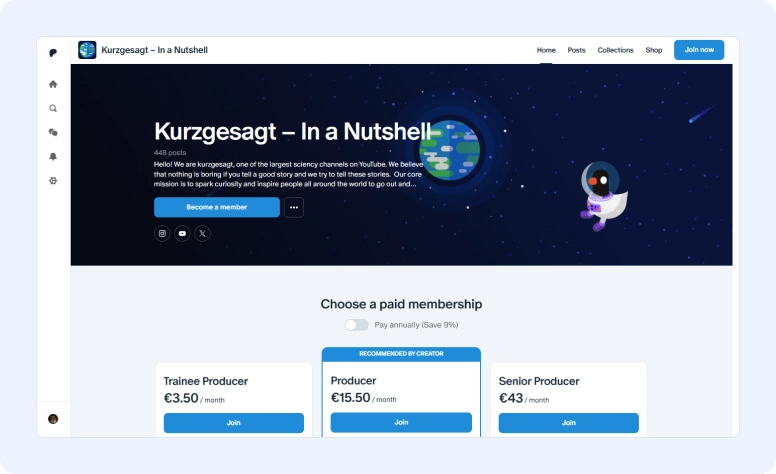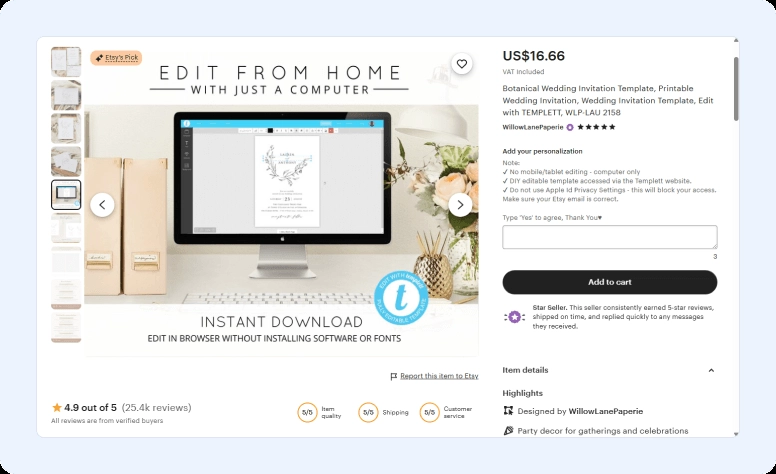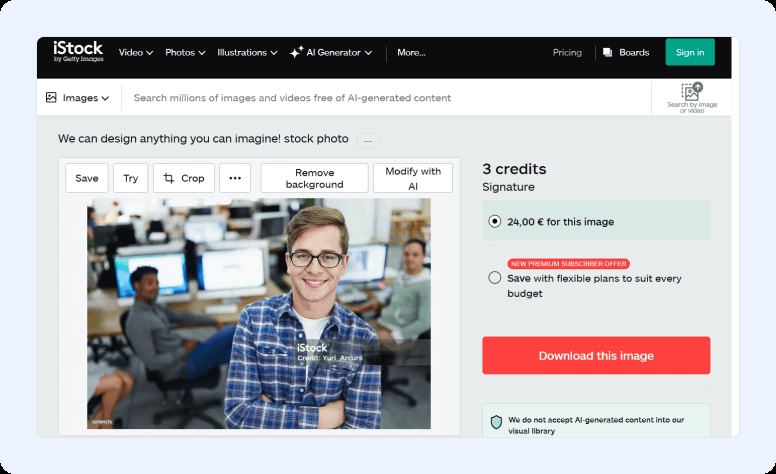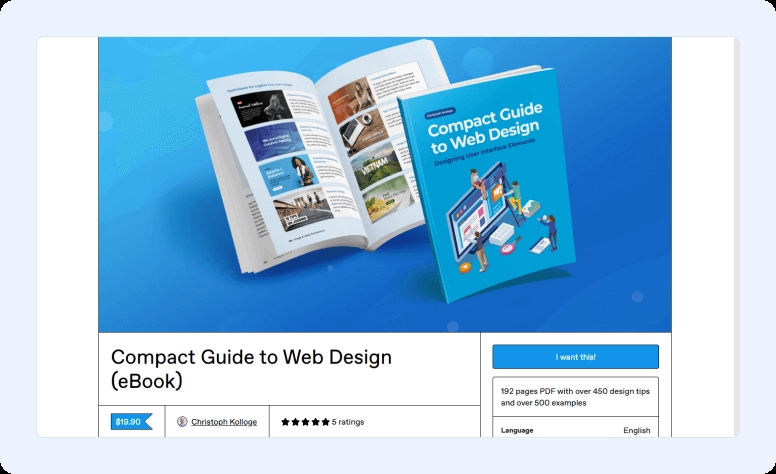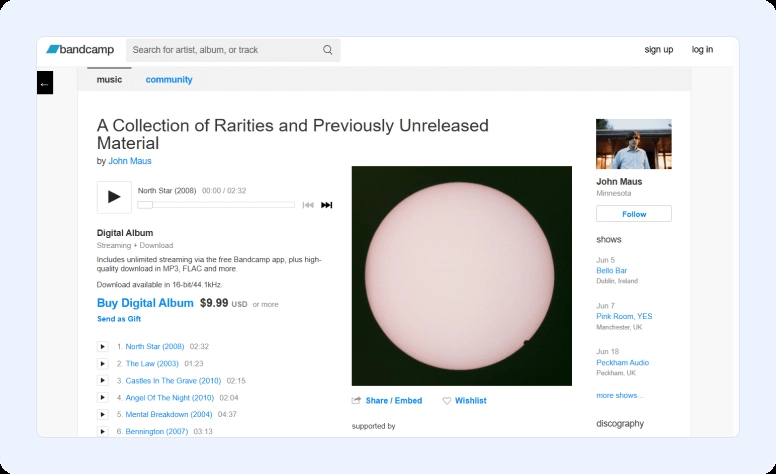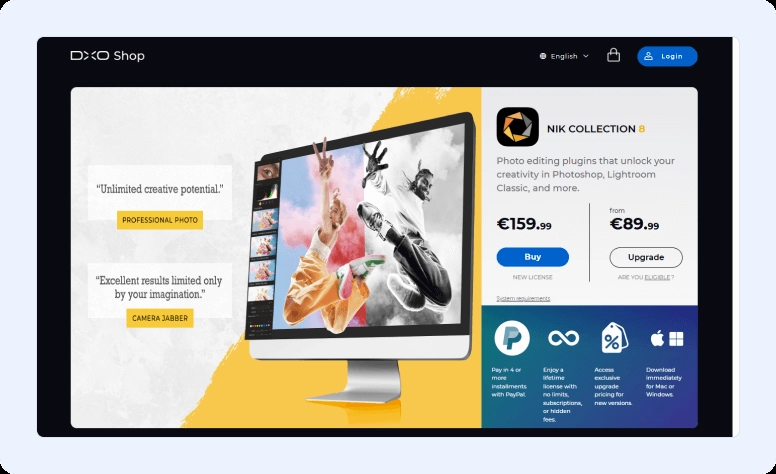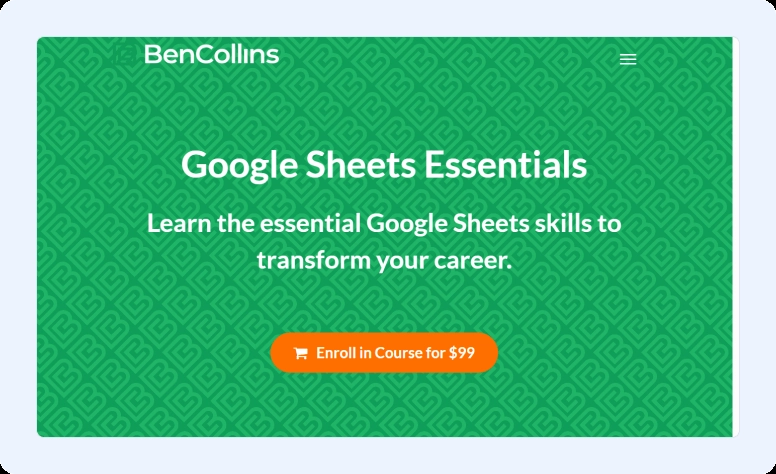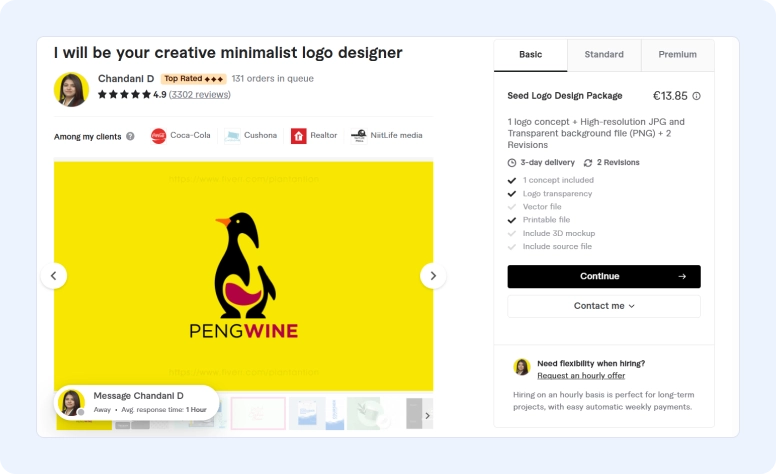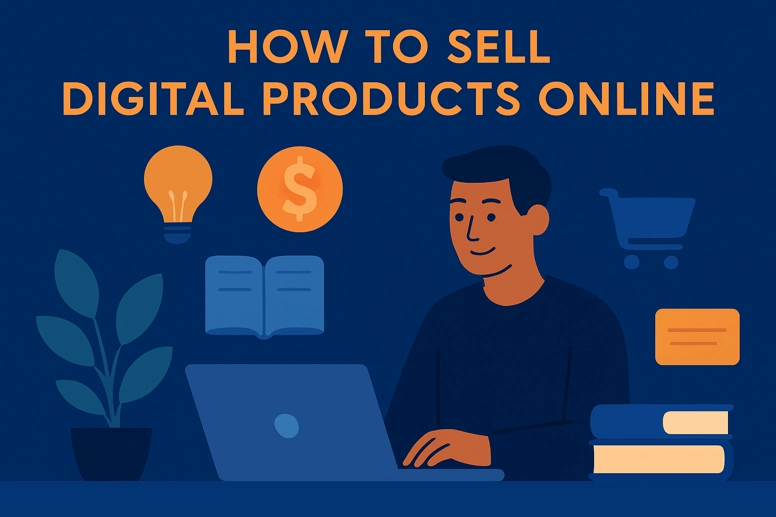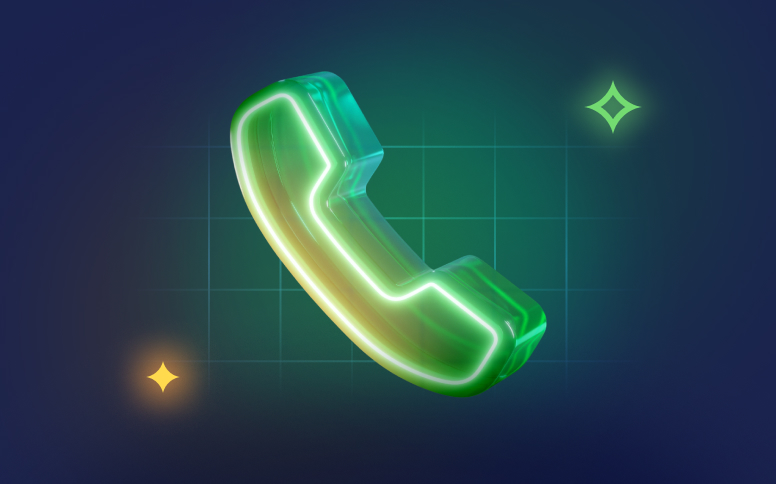The Complete Guide to Selling Digital Products in 2025
There’s no doubt about it—more and more people are diving into selling digital content online. And it’s no surprise, really. We live in a tech-driven world that keeps reshaping how we work, learn, and shop.
According to SellersCommerce, the ecommerce industry is expected to hit a staggering $8 trillion in just two years. That means now’s the time to act. If you run a business, want to start one, or are just figuring things out, starting a digital product business might be a great next step.
Not sure what to sell? The great thing is, you’ve got lots of options when it comes to digital products—like creating an online course, selling stock photos, offering a membership, or even launching a game. And because it’s all digital, there’s no shipping, storage, or boxes to deal with. It’s a quicker, simpler way to sell.
What Are Digital Products?
Simply put, digital products are goods that don’t have a physical format. Customers purchase them and receive access via a download link, email, or online platform—no shipping or packaging involved.
Some popular examples include online courses, software, music, ebooks, and digital art. But they can also include things like mobile apps, design assets, spreadsheets, audiobooks, and even digital planners.
Their popularity keeps growing thanks to low production costs, easy distribution, and strong scalability. That makes them a smart option for creators, freelancers, and business owners alike.
Digital Products Vs Physical Products
You can think of digital products as the modern evolution of physical ones. But what major difference do they have? Digital items can be created once and sold infinitely. On the other hand, physical products need to be manufactured each time someone places an order.
That opens up new possibilities for creators. It cuts out costs for materials, production, packaging, and shipping. It’s also more environmentally friendly and easier to scale.
For example, writing an ebook lets you sell it to thousands with no extra effort, whereas printing a paperback involves ongoing expenses and logistics. A digital planner can be emailed instantly, while a printed one requires warehousing and fulfillment.
Of course, buyer expectations differ too. People expect instant access to digital goods, so your setup needs to be streamlined and automated.
Why Sell Your Digital Products?
As we already mentioned above, selling digital products has a lot of advantages for creators:
- Low costs: There are no inventory or shipping costs.
- High profit margins: These are high since the recurring costs are low or nonexistent in some cases.
- Flexibility: There are many different types of digital products to sell. In fact, you can even incorporate them easily into your current business. You may, for example, sell a license to use your digital products, have a paid subscription to access exclusive content, or anything similar.
- Automation: Since there’s no inventory or shipping involved, it’s easy to automate the entire process—from the sale to delivery to follow-up. Tools like Flowlu let you manage everything in one place: customer contacts, product access, invoices, support tickets, and even content planning.
- Learning Online is Popular: More and more people are looking to learn online since it’s more comfortable and easier to fit into busy schedules. This gives you a huge opportunity.
- Scalability: You can sell to one person or 10,000 without increasing your workload. Once a product is created, your earning potential grows without the need for extra production.
Let’s talk about some examples. A designer can sell Canva templates to bloggers—no shipping, no restocking. A ballet coach can package recorded sessions into an online course and keep earning long after the camera stops rolling.
But just like with everything in life, selling digital goods online has a few drawbacks:
- Access to Free Alternatives: There are always free versions online of similar products. While they may not be as high-quality, you'll need to clearly show why yours is worth paying for.
- Piracy: Unfortunately, digital content can be copied or shared without permission. So, even though you save on shipping and inventory, you’ll likely want to invest in some basic protection for your files or pages.
In the end, it's about more than making money while you sleep. It's about creating something once and letting it keep working for you over time.
Where to Sell a Digital Product
If you’re thinking about selling digital products, there are plenty of ways to do it. Different platforms offer different tools, depending on what you’re selling and how hands-on you want to be.
Here are the main options:
- Build your own online store where you can list your products and promote them using content marketing, email, and SEO.
- Use social media platforms to promote your digital products—and in some cases, even sell directly from your profile.
- List your products on major marketplaces that handle the infrastructure so you can focus on creating and selling.
Each of these channels has its own tools and platforms to help you get started. Depending on what you're selling, here are some top options worth checking out:
- Etsy – Ideal for printables, templates, and digital art.
- Gumroad and Sellfy – Simple, creator-friendly platforms for ebooks, software, or memberships.
- Teachable, Podia, and Thinkific – Tailored for selling online courses and digital workshops.
- Shopify – A full-featured ecommerce solution if you're building a standalone digital storefront.
- Patreon or Memberful – Perfect for membership-based content, ongoing releases, or community-focused creators.
- Creative Market and Envato – Great for selling design assets, stock photos, or fonts.
You don’t have to limit yourself to one platform. You can sell your main product on Gumroad, promote it through Instagram to reach more people, and offer a freebie on your website to grow your email list.
There’s no single “right” way to do this. Pick what makes the most sense for you and your product—and just make sure it’s easy for people to buy and get what they paid for.
The Top 8 Digital Products to Sell Online
Not sure what kind of digital product to sell? That’s totally normal—there’s a lot to choose from. The great part is, you don’t need to fit into a specific box. If you like teaching, designing, writing, or creating music, there’s something here that can work for you. Here are 8 types of digital products that people are successfully selling online—and that you can, too.
#1: Digital Memberships
Think of digital memberships as your own little VIP club. People pay you every month (or year) to get access to something they can’t find anywhere else—maybe it’s exclusive content, early product drops, members-only events, or just the satisfaction of being part of the “in” crowd.
And do you know the beauty of this setup? You’re not starting from scratch every time you make a sale. Instead of chasing one-off purchases, you’re building steady, reliable income—like a digital subscription box, but with less packaging.
And this model works for all kinds of creators. A fitness coach might offer weekly workout plans and live Q&As. A designer could drop fresh templates each month. A writer? Maybe a behind-the-scenes newsletter or a monthly short story club.
You can keep things simple by using platforms like Patreon or Memberful, or set up your own space using tools like Podia or a WordPress plugin.
Make sure whatever you’re offering feels genuinely useful (or at least fun) so people want to stick around.
#2: Printable Digital Goods
Printables are one of the easiest ways to turn your ideas into something people will pay for. Think planners, wall art, habit trackers, greeting cards, budget sheets—anything someone might want to print and use at home.
You create the design once, upload it, and that’s it. No stock, no shipping, no dealing with returns. People download it, print it on their end, and you get paid.
This works well if you have a good eye for layout or love making things that help others stay organized, decorate their space, or get stuff done. Plus, once you build a small collection, you can bundle items or sell themed packs to increase value without much extra work.
#3: Licensed Digital Content
If you make original stuff like stock photos, music tracks, sound effects, or video clips, you can license it and sell it online. It’s a solid way to turn your creative work into ongoing income—especially since people in marketing, film, YouTube, and podcasting are always looking for quality content they can legally use.
You can sell your work through your own site or list it on platforms that specialize in licensed content like AudioJungle, Shutterstock, or Pond5.
Ensure to protect your files. Add watermarks or previews to prevent free downloads and clearly state how people are allowed to use your work. A simple license agreement can go a long way.
#4: Ebooks
Ebooks are one of the first things that come to mind when people think about digital products—and for good reason. They’re pretty straightforward to make, easy to share, and work on almost any device.
But let’s be honest: there are tons of ebooks out there. If you want yours to sell, it needs to offer something different. That could be solving a specific problem, sharing a unique take, or drawing from your own experience to make it truly useful.
You don’t have to write a long book, either. Short, practical guides often do better—especially if they help people learn something fast or take action right away. Giving away a free sample, like the first chapter or a few pages, can also turn browsers into buyers.
If you’ve got useful knowledge and a clear idea, an ebook is a simple, low-cost way to get started.
#5: Art, Music & Other Creative Work
Selling digital products goes beyond course creators and marketers. Creatives like artists and musicians have lots of ways to earn online, too.
You can share your work on digital galleries, music sites, or even use crowdfunding to support new projects. Social media also helps you grow an audience and get your work in front of more people.
It’s smart to use platforms that fit your style—like Bandcamp for music, Gumroad for art, or Ko-fi for all kinds of digital downloads. The more specific the platform, the easier it is for the right audience to find you.
#6: Digital Templates & Tools
Templates and digital tools are popular because they save time, help people look polished, and make work easier—and that’s exactly what buyers want.
You can make templates for almost anything: resumes, slide decks, social media posts, invoices, emails, websites—whatever fits your skills. Digital tools can be simple too, like a spreadsheet that does the math for you or a plugin for Photoshop or Premiere Pro.
These kinds of products work well for freelancers, marketers, small business owners, and creators who want to move fast without starting from scratch. If you can make something once that solves a real problem, chances are people will pay for it.
#7: Online Courses & Educational Products
Online courses are one of the most popular digital products out there—and it’s easy to see why. People are always looking to pick up new skills, and they like learning at their own pace.
You don’t need to be a teacher to share something valuable. You could create a full course, record a quick workshop, or sell downloadable guides and tutorials. If you know how to do something well, chances are someone else wants to learn it.
The great thing is, once your course is built, you can sell it again and again. Make sure it stays useful and up to date. Things like quizzes, checklists, and mini tasks can help make it more interactive.
Platforms like Teachable, Thinkific, and Podia make it simple to host and sell your course—no tech skills needed.
#8: Digital Services
Not all digital products are downloads. Some are services you can deliver online. Think logo design, video editing, copywriting, coaching, consulting, personal training, and more.
If you already offer a service, turning it into a digital product often comes down to how you package it. For example, instead of offering “coaching,” you could sell a one-time video session, a recorded plan, or a bundle that includes templates and email support.
The trick is to stick with services you can offer remotely. You don’t have to start from scratch—simply package your existing skills in a way that works online and meets current demand. If you're offering coaching, freelance work, or consulting, a platform like Flowlu helps you organize your workflow, track client requests, and take care of scheduling and payments—all from one simple dashboard.
How To Sell Digital Products Online
Selling digital products doesn’t have to be hard. It’s really about making something helpful, getting it in front of the right audience, and keeping the buying process streamlined. Here’s a straightforward way to get started:
Step #1: Build an Audience First
You should not wait until your product is ready to start talking about it. Warming up your audience early can make launch day a lot smoother.
Here are a few easy ways to get started:
- Share sneak peeks or behind-the-scenes content on social media
- Start an email list and offer a freebie to get signups (like a checklist or sample)
- Host a casual Q&A or mini-webinar to introduce the topic
- Join relevant communities on Reddit, Discord, or Facebook and start contributing
This early interest helps you build trust, test ideas, and gather feedback before you’ve even created the full product.
Step 2: Create (or Find) a Digital Product
Next up—your actual product. You can either make your own or sell someone else’s as an affiliate.
If you're creating your own, think about what you're good at and what your audience actually needs. It could be:
- Music or sound effects
- Fonts or design templates
- Online courses or video lessons
- Software, plugins, or tools
- Digital art, ebooks, or entertainment content
No time to create something from scratch? Join an affiliate program and promote a product you believe in. You’ll earn a commission for every sale you help generate.
Step #3: Validate Your Idea
Before you spend time building your product, make sure people actually want it. This step helps you avoid launching something no one’s looking for.
Here are a few simple ways to test your idea:
- Check Google Trends to see if interest in your topic is growing or fading
- Do basic keyword research to find out how many people are searching for your idea
- Browse niche forums and Facebook groups to see what questions come up again and again
- Read reviews of similar products—what are people loving or complaining about?
You don’t need a massive audience or a fancy survey. A bit of digging can give you confidence (or a reality check) before you build.
Step #4: Decide on Pricing
Now it’s time to decide what to charge. Pricing can seem tough, but it’s easier when you think about it from your customer’s point of view.
Here are a few quick tips:
- Price for value: Think about what outcome or benefit your product delivers—not the number of pages or hours.
- Offer tiers: A free version can attract new users, while a premium version gives more serious buyers something extra.
- Use smart pricing: $19 often feels cheaper than $20, even though it’s basically the same.
- Check the market: See what similar products cost on Etsy, Gumroad, or course platforms to stay competitive.
Your price doesn't have to be ideal from the beginning. You can always test different price points and adjust based on customer feedback and results.
Step #5: Set Up Your Online Store
Once your idea is tested and your product is ready, it’s time to launch.
Nowadays, you don’t need to hire a developer or spend weeks building a website. Tools like Shopify, Podia, and Gumroad let you upload your product, write a quick description, and start taking payments in no time. Want more control? WordPress with WooCommerce lets you customize things your way.
Keep it simple—your main goal is to make the buying process fast, smooth, and secure. If you’re also juggling services, project-based work, or content alongside your store, a business platform like Flowlu can help you keep everything in one spot—CRM, invoicing, planning, and docs all included.
Step #6: Market Your Products
Now comes the part where you help people actually find and buy your product.
You don’t need to be on every platform—just pick the ones your audience already uses. Instagram is great for visual products like templates or art, LinkedIn works well for business tools, and TikTok is perfect for quick demos or behind-the-scenes content.
Here are a few marketing ideas to get started:
- Run social ads to drive traffic to your store
- Use lead magnets like free downloads to grow your email list
- Create helpful content like tutorials, how-tos, or quick tips
- Show behind-the-scenes moments to build connection and trust
- Share customer feedback or success stories to build social proof
You don’t need to do all of these at once—just pick one or two and get consistent.
Step #7: Build Trust With Support & Refund Options
Even with digital products, people want to feel taken care of. A few simple things can make a big difference:
- Offer a clear refund policy (7 or 14 days works well for most creators)
- Create a basic FAQ page for common questions or download issues
- Set up an auto-reply for support emails so people know you’ll get back to them soon
It doesn’t need to be fancy—just make it easy for buyers to trust that if something goes wrong, they’re not left in the dark.
Step #8: Don’t Skip Legal Protection
It’s easy to overlook the legal side of digital products, but protecting your work helps prevent headaches later. Here are a few simple things to put in place:
- Copyright your work and make it clear how others are allowed to use it (personal use, commercial, etc.)
- Include Terms of Use and a refund policy on your product or website
- Add watermarks or PDF stamps for things like ebooks, planners, or templates
- If you're selling software, consider basic DRM tools to prevent unauthorized use
These don’t need to be complex or expensive, but a little protection goes a long way—especially when your products start gaining traction.
Bottom Line
Selling digital products is one of the simplest ways to earn income online. Throughout this guide, we covered the most popular types of digital products, how to choose the right one, and the steps to start selling—from building your audience to protecting your work.
The great thing is, you can make something once and keep selling it—no packing boxes, managing inventory, or worrying about storage. But it still takes effort. You’ll need a bit of planning, some trial and error, and a good dose of patience.
If you’re up for starting small, learning along the way, and staying consistent, digital products can be a flexible and satisfying way to earn doing something you enjoy.
You’ve got two main paths to choose from. You can promote a product you believe in as an affiliate and earn a commission on each sale, or you can create your own digital product and sell it yourself. If you go the DIY route, you can use your own online store or list your product on sites like Gumroad, Etsy, or Teachable—it all depends on what you're selling.
If you want a tool to handle everything in one place—sales, tasks, content, and automation—Flowlu gives you a full toolkit to help digital product creators stay on track and work smarter.
It depends a bit on your niche, but some top-performing digital products across industries include:
- Online courses and workshops
- Printables (like planners or checklists)
- Templates and design assets
- Software and mobile apps
- Membership sites
- Audiobooks and ebooks
- Workbooks and toolkits
The key is offering something useful that solves a real problem or saves time.
Start with an idea that plays to your strengths and solves a specific need. Once you’ve got a few options, validate them—check search trends, join online communities, and look at what’s already selling.
Once you’ve locked in your idea:
- Create the product (this could be a PDF, video, app, etc.)
- Set up a place to sell it (like a Shopify store or Gumroad page)
- Start marketing to your target audience
You don’t need to be perfect—just helpful, clear, and consistent.
That’s up to you. Some sellers offer refunds, others don’t. If you do, set clear terms upfront—like how long customers have to request one (7, 14, or 30 days) and under what conditions.
For example, you might:
- Limit refunds after a product is downloaded
- Offer refunds only if the product wasn’t accessed
- Refund to the original payment method or offer store credit
Whatever you choose, make sure your refund policy is easy to find on your website to avoid confusion or disputes.
You can’t stop every leak, but you can definitely make it harder. Here’s how:
- For PDFs and downloads: Add visible or invisible watermarks, like the buyer’s email or order number, to trace where leaks come from.
- For software or code-based products: Obfuscate the code and use license checks to stop unauthorized use or distribution.
- For memberships and subscriptions: Use license keys or server-side authentication. When someone stops paying, their access ends automatically.
A bit of prevention can save you a lot of stress down the road.








